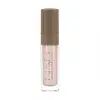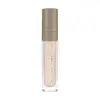What's inside
What's inside
 Key Ingredients
Key Ingredients

 Benefits
Benefits

 Concerns
Concerns

 Ingredients Side-by-side
Ingredients Side-by-side

Water
Skin ConditioningIsododecane
EmollientTalc
AbrasivePEG-10 Dimethicone
Skin ConditioningTriethylhexanoin
MaskingSynthetic Fluorphlogopite
Ethylhexyl Palmitate
EmollientGlycerin
HumectantPropanediol
SolventDisteardimonium Hectorite
StabilisingSambucus Nigra Fruit Extract
AstringentSodium Chloride
MaskingTocopheryl Acetate
AntioxidantTroxerutin
Skin ConditioningAloe Barbadensis Leaf Juice Powder
Skin ConditioningSodium Ascorbyl Phosphate
AntioxidantHexyl Laurate
EmollientPolyglyceryl-4 Isostearate
EmulsifyingCetyl PEG/PPG-10/1 Dimethicone
EmulsifyingXanthan Gum
EmulsifyingCellulose
AbsorbentEthylhexylglycerin
Skin ConditioningPropylene Carbonate
SolventGlyceryl Rosinate
PerfumingPhenoxyethanol
PreservativeAlumina
AbrasiveTriethoxycaprylylsilane
Sodium Sulfate
Silica Dimethyl Silylate
EmollientParfum
MaskingLinalool
PerfumingCitronellol
PerfumingLimonene
PerfumingCI 77891
Cosmetic ColorantCI 42090
Cosmetic ColorantCI 77491
Cosmetic ColorantWater, Isododecane, Talc, PEG-10 Dimethicone, Triethylhexanoin, Synthetic Fluorphlogopite, Ethylhexyl Palmitate, Glycerin, Propanediol, Disteardimonium Hectorite, Sambucus Nigra Fruit Extract, Sodium Chloride, Tocopheryl Acetate, Troxerutin, Aloe Barbadensis Leaf Juice Powder, Sodium Ascorbyl Phosphate, Hexyl Laurate, Polyglyceryl-4 Isostearate, Cetyl PEG/PPG-10/1 Dimethicone, Xanthan Gum, Cellulose, Ethylhexylglycerin, Propylene Carbonate, Glyceryl Rosinate, Phenoxyethanol, Alumina, Triethoxycaprylylsilane, Sodium Sulfate, Silica Dimethyl Silylate, Parfum, Linalool, Citronellol, Limonene, CI 77891, CI 42090, CI 77491
Water
Skin ConditioningCyclopentasiloxane
EmollientIsododecane
EmollientTalc
AbrasivePropylene Glycol
HumectantHydrogenated Polydecene
EmollientBoron Nitride
AbsorbentSynthetic Fluorphlogopite
Polyglyceryl-4 Isostearate
EmulsifyingCetyl PEG/PPG-10/1 Dimethicone
EmulsifyingHexyl Laurate
EmollientTocopheryl Acetate
AntioxidantMagnesium Sulfate
Glycerin
HumectantAscorbyl Palmitate
AntioxidantTriethoxycaprylylsilane
Phenoxyethanol
PreservativeAlumina
AbrasiveAcrylates Copolymer
Lauryl PEG/PPG-18/18 Methicone
Skin ConditioningMalpighia Glabra Fruit Extract
Skin ConditioningPhragmites Karka Extract
Skin ConditioningPoria Cocos Extract
Skin ConditioningAlcohol
AntimicrobialPPG-2-Deceth-30
EmulsifyingEthylhexylglycerin
Skin Conditioning1,2-Hexanediol
Skin ConditioningIsostearyl Alcohol
EmollientSodium Laureth Sulfate
CleansingBiosaccharide Gum-4
Skin ConditioningSodium Dehydroacetate
PreservativeSodium Citrate
BufferingSodium Benzoate
MaskingCitric Acid
BufferingPotassium Sorbate
PreservativeCI 77891
Cosmetic ColorantCI 77492
Cosmetic ColorantCI 77491
Cosmetic ColorantCI 77499
Cosmetic ColorantWater, Cyclopentasiloxane, Isododecane, Talc, Propylene Glycol, Hydrogenated Polydecene, Boron Nitride, Synthetic Fluorphlogopite, Polyglyceryl-4 Isostearate, Cetyl PEG/PPG-10/1 Dimethicone, Hexyl Laurate, Tocopheryl Acetate, Magnesium Sulfate, Glycerin, Ascorbyl Palmitate, Triethoxycaprylylsilane, Phenoxyethanol, Alumina, Acrylates Copolymer, Lauryl PEG/PPG-18/18 Methicone, Malpighia Glabra Fruit Extract, Phragmites Karka Extract, Poria Cocos Extract, Alcohol, PPG-2-Deceth-30, Ethylhexylglycerin, 1,2-Hexanediol, Isostearyl Alcohol, Sodium Laureth Sulfate, Biosaccharide Gum-4, Sodium Dehydroacetate, Sodium Citrate, Sodium Benzoate, Citric Acid, Potassium Sorbate, CI 77891, CI 77492, CI 77491, CI 77499
Ingredients Explained
These ingredients are found in both products.
Ingredients higher up in an ingredient list are typically present in a larger amount.
Alumina is another name for the compound aluminum oxide. It is used as a thickener, absorbent, and abrasive.
As an absorbent, alumina can give a mattifying effect. It is used in mineral sunscreens to help coat nano-sized filters, such as titanium dioxide. By increasing the size of the UV filters, these ingredients stay on the skin for a longer time. By coating small sized ingredients, alumina helps thicken a product.
Alumina may be used as an abrasive, or exfoliant.
Alumina is naturally occurring in the mineral corundum. Certain varieties of corundum create rubies and sapphires. Corundum is also the crystalline form of alumina.
Learn more about AluminaThis ingredient is a high molecular weight silicone. It has emulsifying and skin conditioning properties.
Ci 77491 is also hydrated iron III oxide. It's sole purpose is to give a red/pink hue to products.
Iron III oxides are classified as inorganic chemicals for coloring.
Synthetically created Ci 77491 is considered safer than those naturally found. This is because the synthetically created version may contain less impurities. Iron oxides are generally non-toxic and non-allergenic.
Learn more about CI 77491Ci 77891 is a white pigment from Titanium dioxide. It is naturally found in minerals such as rutile and ilmenite.
It's main function is to add a white color to cosmetics. It can also be mixed with other colors to create different shades.
Ci 77891 is commonly found in sunscreens due to its ability to block UV rays.
Learn more about CI 77891Ethylhexylglycerin (we can't pronounce this either) is commonly used as a preservative and skin softener. It is derived from glyceryl.
You might see Ethylhexylglycerin often paired with other preservatives such as phenoxyethanol. Ethylhexylglycerin has been found to increase the effectiveness of these other preservatives.
Glycerin is already naturally found in your skin. It helps moisturize and protect your skin.
A study from 2016 found glycerin to be more effective as a humectant than AHAs and hyaluronic acid.
As a humectant, it helps the skin stay hydrated by pulling moisture to your skin. The low molecular weight of glycerin allows it to pull moisture into the deeper layers of your skin.
Hydrated skin improves your skin barrier; Your skin barrier helps protect against irritants and bacteria.
Glycerin has also been found to have antimicrobial and antiviral properties. Due to these properties, glycerin is often used in wound and burn treatments.
In cosmetics, glycerin is usually derived from plants such as soybean or palm. However, it can also be sourced from animals, such as tallow or animal fat.
This ingredient is organic, colorless, odorless, and non-toxic.
Glycerin is the name for this ingredient in American English. British English uses Glycerol/Glycerine.
Learn more about GlycerinHexyl Laurate isn't fungal acne safe.
Isododecane is a fragrance, emollient, and solvent.
As an emollient, it helps your skin stay soft and hydrated. Emollients help trap moisture into your skin.
Isododecane's role as a solvent makes it a great texture enhancer. It spreads smoothly on skin and does not leave a sticky feeling behind. Isododecane also helps prevent color transfer in makeup products.
Isododecane is not absorbed into skin.
Learn more about IsododecanePhenoxyethanol is a preservative that has germicide, antimicrobial, and aromatic properties. Studies show that phenoxyethanol can prevent microbial growth. By itself, it has a scent that is similar to that of a rose.
It's often used in formulations along with Caprylyl Glycol to preserve the shelf life of products.
This ingredient is an emulsifer and stabilizer. It comes from isostearic acid and polyglycerin.
As an emulsifier, it helps blend oil and water to improve texture, spreadbility, and application.
Due to it being derived from isostearic acid, this ingredient may not be fungal acne safe.
Learn more about Polyglyceryl-4 IsostearateSynthetic Fluorphlogopite is the synthethic version of mica. It consists of fluorine, aluminum and silicate.
Synthetic Fluorphlogopite is used to add volume to products.
It is considered non-irritating on the skin.
Learn more about Synthetic FluorphlogopiteTalc is a clay mineral. It helps absorb moisture and improve the texture of products. Like other types of clay, Talc can have a slight exfoliating effect on skin. Talc can be added to increase the volume of products.
Some Baby powders are made by combining talc with corn starch. The word "talc" comes from Latin and originates from Arabic. Talc is a mineral commonly found throughout the world.
If you have any concerns about using talc, we recommend checking out the FDA's official page.
Learn more about TalcTocopheryl Acetate is AKA Vitamin E. It is an antioxidant and protects your skin from free radicals. Free radicals damage the skin by breaking down collagen.
One study found using Tocopheryl Acetate with Vitamin C decreased the number of sunburned cells.
Tocopheryl Acetate is commonly found in both skincare and dietary supplements.
Learn more about Tocopheryl AcetateTriethoxycaprylylsilane is a silicone used to bind and stabilize ingredients.
As an emulsifier, it helps prevent ingredients from separating. This can help elongate the shelf life of products.
Triethoxycaprylylsilane is often used to coat mineral sunscreens ingredients to help give a better feel. It also helps reduce oxidative stress in sunscreens.
Learn more about TriethoxycaprylylsilaneWater. It's the most common cosmetic ingredient of all. You'll usually see it at the top of ingredient lists, meaning that it makes up the largest part of the product.
So why is it so popular? Water most often acts as a solvent - this means that it helps dissolve other ingredients into the formulation.
You'll also recognize water as that liquid we all need to stay alive. If you see this, drink a glass of water. Stay hydrated!
Learn more about Water